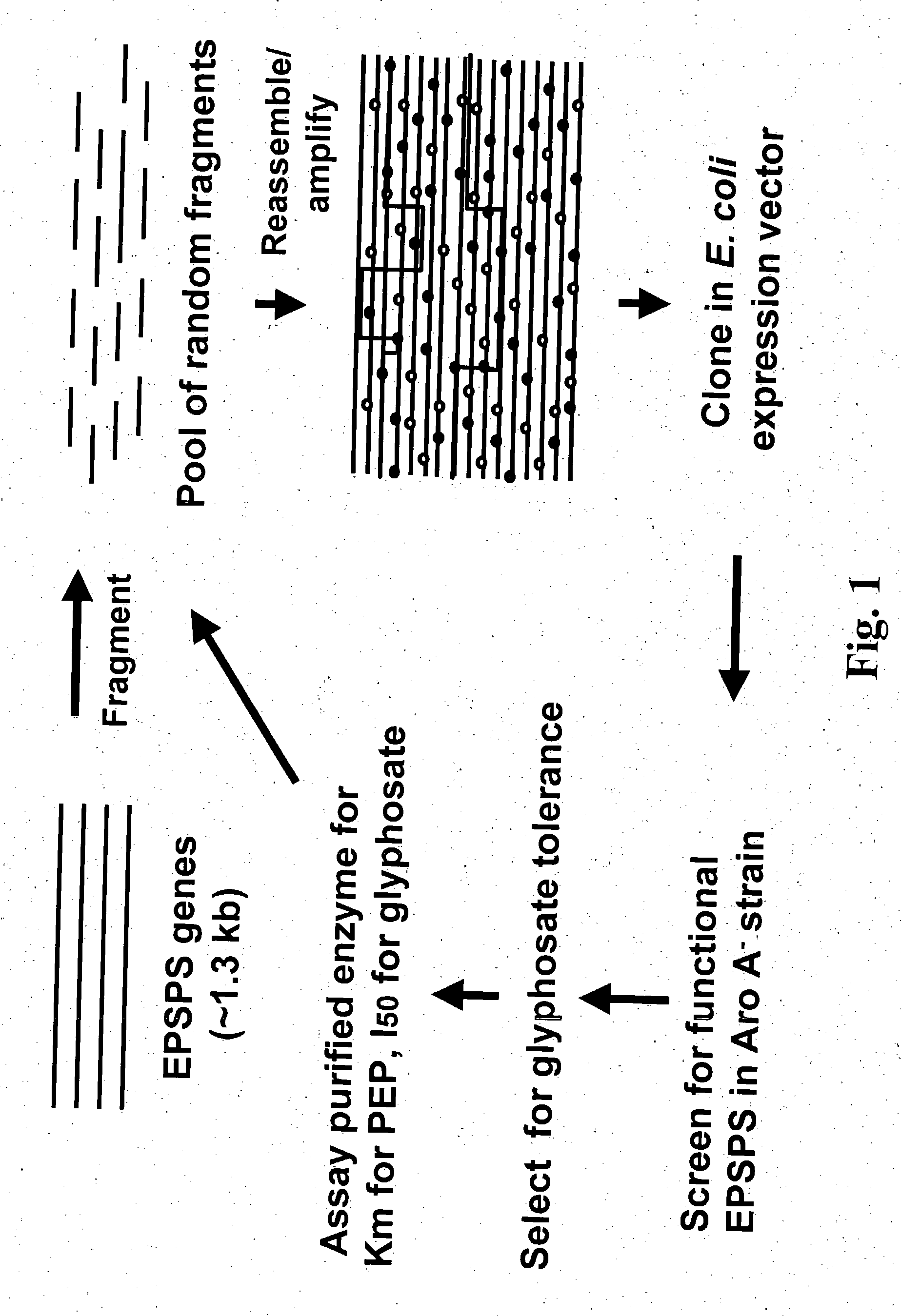DNA shuffling to produce herbicide selective crops
a technology of nucleic acids and selective crops, applied in the field of nucleic acid shuffling, can solve the problems of no assurance that any gene will be identified that provides, simple serendipitous, and a large task, and achieves the effects of increasing the range of herbicides, increasing expression levels, and increasing the ability to metaboliz
- Summary
- Abstract
- Description
- Claims
- Application Information
AI Technical Summary
Benefits of technology
Problems solved by technology
Method used
Image
Examples
example 1
Shuffling of Plant EPSPS Genes for Glyphosate Tolerance
[0244] Arabidopsis EPSPS cDNA is PCR amplified from reverse transcribed RNA using the primers 5′-GCAGT CCATG GAGAA AAGCG TCGGA GATTG TACTT CAACC C-3′ and 5′-TAGAC TAAGA TCTGT GCTTT GTGAT TCTTT CAAGT ACTTG G-3′. Digestion of the fragment with NcoI and BglII is followed by directional cloning into the prokaryotic expression vector pQE60 (QIAGEN) and introduction into the E. coli AroA-strain AB2829 (Pittard, 1966). Likewise, a tomato cDNA is amplified with the primers 5′-ACGTC CATGG CAAAA CCCCA TGAGA TTGTG CTAG-3′ and 5′ CAGTA GATCT GTGCT TAGAG TACTT CTGGA G-3′ from purified phage DNA of a cDNA library (Stratagene), cloned into pQE60, and introduced into AB2829 cells. Growth of the transformed cells on minimal media devoid of aromatic amino acids demonstrates functional complementation of the AroA mutation by expression of the cloned EPSPS genes.
[0245] Universal M13 forward and reverse primers are used to PCR amplify both the Ara...
example 2
Tolerance to Glyphosate in Recombinant Forms of EPSP Synthase
[0247] EPSP synthase activity is assayed in the forward direction by monitoring production of phosphate with the malachite green colorimetric assay (Lanzetta P A et al., Anal. Biochem. 100:95-97, 1979). Reactions are performed in assay buffer (50 mM HEPES, pH 7.0 and 0.1 mM ammonium molybdate) containing enzyme, 0.1 mM phosphoenolpyruvate, 0.1 mM shikimate-3-phosphate and various concentrations of glyphosate, in a final volume of 0.2 ml. After 20 min, reactions are terminated by the addition of 0.7 ml of malachite green reagent (3 parts of 0.045% malachite green to 1 part 4.2% ammonium molybdate). After 10 min, absorbance at 660 nm is determined with a Beckman DU 600 spectrophotometer. The inhibition constant of each enzyme for glyphosate (I50) is derived from a plot of percent activity versus glyphosate concentration. The Km for PEP is derived from a plot of rate of rate of product formed versus PEP concentration.
PUM
| Property | Measurement | Unit |
|---|---|---|
| Tm | aaaaa | aaaaa |
| temperature | aaaaa | aaaaa |
| pH | aaaaa | aaaaa |
Abstract
Description
Claims
Application Information
 Login to View More
Login to View More - R&D
- Intellectual Property
- Life Sciences
- Materials
- Tech Scout
- Unparalleled Data Quality
- Higher Quality Content
- 60% Fewer Hallucinations
Browse by: Latest US Patents, China's latest patents, Technical Efficacy Thesaurus, Application Domain, Technology Topic, Popular Technical Reports.
© 2025 PatSnap. All rights reserved.Legal|Privacy policy|Modern Slavery Act Transparency Statement|Sitemap|About US| Contact US: help@patsnap.com

